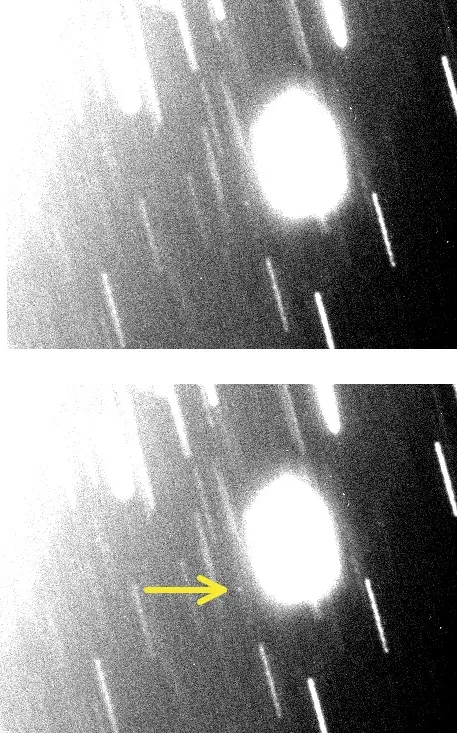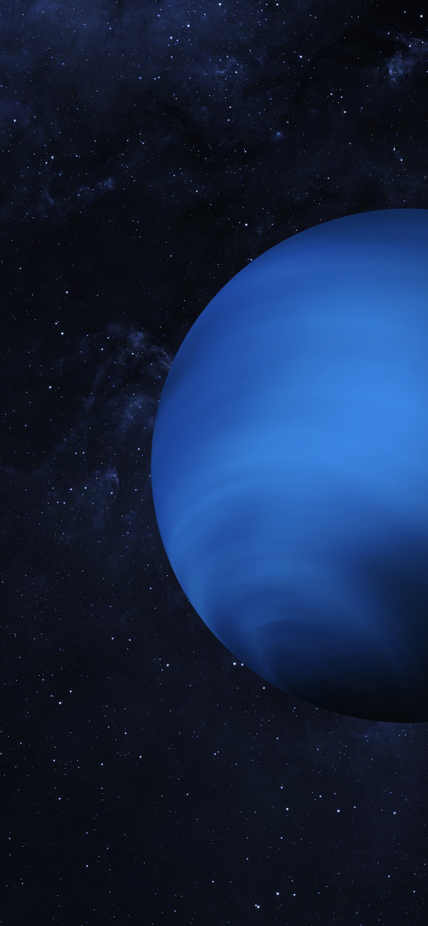Washington, D.C.— The Solar System has some new lunar members—the first new moon of Uranus discovered in more than 20 years, and likely the smallest, as well as two new moons of Neptune, one of which is the faintest moon ever discovered by ground-based telescopes. The discoveries were announced today by the International Astronomical Union's Minor Planet Center.
“The three newly discovered moons are the faintest ever found around these two ice giant planets using ground-based telescopes,” explained Carnegie Science’s Scott S. Sheppard. “It took special image processing to reveal such faint objects.”
The new Uranian member brings the ice giant planet’s total moon count to 28. At only 8 kilometers, it is probably the smallest of Uranus’ moons. It takes 680 days to orbit the planet. Provisionally named S/2023 U1, the new moon will eventually be named after a character from a Shakespeare play, in keeping with the naming conventions for outer Uranian satellites.
S/2023 U1 was first spotted on November 4, 2023, by Sheppard using the Magellan telescopes at Carnegie Science’s Las Campanas Observatory in Chile. Sheppard made follow-up observations at Magellan a month later in December. Using the month of observations and working with Marina Brozovic and Bob Jacobson of NASA’s Jet Propulsion Laboratory to determine a possible moon orbit for the new find, Sheppard was able to locate the new member of Uranus’ pantheon in older images that he’d taken in 2021 at Magellan, as well as at the Subaru telescope in Hawaii.
Sheppard also used the Magellan Telescope to find the brighter of the two newfound Neptunian moons. In collaboration with David Tholen of the University of Hawaii, Chad Trujillo of Northern Arizona University, and Patryk Sofia Lykawa of Kindai University, he found the other new Neptunian moon, an extremely faint object, using the Subaru telescope. Both were first seen in September 2021.
Follow-up observations on the Magellan telescopes in October of 2021 and again in 2022 and November 2023 confirmed the brighter Neptunian moon as orbiting Neptune. The fainter moon required special observing time under ultra-pristine conditions at the European Southern Observatory’s Very Large Telescope and on Gemini Observatory’s 8-meter telescope in order to secure its orbit. Brozovic and Jacobson were essential to this process of fitting the moon’s orbit around Neptune using the data from the earlier 2021 observations to predict where to point the telescopes in 2022 and 2023 to find the extremely faint object.
The brighter Neptune moon now has a provisional designation S/2002 N5, is about 23 kilometers in size, and takes almost 9 years to orbit the ice giant. The fainter Neptune moon has a provisional designation S/2021 N1 and is about 14 kilometers with an orbit of almost 27 years. They will both receive permanent names based on the 50 Nereid sea goddesses in Greek mythology.
“Once S/2002 N5’s orbit around Neptune was determined using the 2021, 2022, and 2023 observations, it was traced back to an object that was spotted near Neptune in 2003 but lost before it could be confirmed as orbiting the planet,” Sheppard explained.
Discovering all three of the new moons required taking dozens of five-minute exposures over three- or four-hour periods on a series of nights. These exposures were shifted by the apparent motion of each respective planet and added together to create one very deep image. Using this time intensive observing technique on some of the largest telescopes in the world allowed the survey images to go deeper than any previous observations near Uranus and Neptune.
“Because the moons move in just a few minutes relative to the background stars and galaxies, single long exposures are not ideal for capturing deep images of moving objects,” Sheppard said. “By layering these multiple exposures together, stars and galaxies appear with trails behind them, and objects in motion similar to the host planet will be seen as point sources, bringing the moons out from behind the background noise in the images.”
All of the new Uranian and Neptunian moons have distant, eccentric, and inclined orbits that suggests they were captured by the gravity of these planets during or shortly after Uranus and Neptune formed from the ring of dust and debris that surrounded our Sun in its infancy. All of the giant planets in our Solar System have similar configurations for their outer moons, regardless of their size or the process by which they formed.

“Even Uranus, which is tipped on its side, has a similar moon population to the other giant planets orbiting our Sun,” Sheppard explained. “And Neptune, which likely captured the distant Kuiper Belt object Triton—an ice rich body larger than Pluto—an event that could have disrupted its moon system, has outer moons that appear similar to its neighbors."
Better understanding the history of how these outer moons were captured can help astronomers like Sheppard and his colleagues elucidate new details about the tumultuous early years of our Solar System’s history and the movement of the planets on its outer edges. Possible future space missions to Uranus and Neptune that are in the planning phases will enhance this knowledge and allow researchers to see these newly discovered moons with new eyes.
The new moons also show there are dynamical orbital groupings of outer moons around Uranus and Neptune, like those found around Jupiter and Saturn. At Uranus, S/2023 U1 has a similar orbit as Caliban and Stephano. At Neptune, S/2021 N1 has a similar orbit as Psamathe and Neso while S/2002 N5 has a similar orbit as Sao and Laomedeia. These groupings suggest once larger parent moons have been broken apart by past collisions, probably with comets or asteroids, leaving the broken fragments behind in similar orbits as the original larger moon. Many smaller moon fragments likely exist in these groupings, but they are generally too faint to efficiently observe with current technology. These moon groupings show the early Solar System was a very chaotic place with the movement and collisions happening between various objects all of the time.
The new observations likely complete the inventories of Uranus and Neptune’s moons down to between 8 and 14 kilometers respectively. In comparison, Jupiter is complete to moons of about 2 kilometers in size, while Saturn is complete to moons of about 3 kilometers in size.
